NCERT Solutions for Class 12 Economics - Index Numbers
Q1: An index number which accounts for the relative importance of the items is known as
(i) weighted index
(ii) simple aggregative index
(iii) simple average of relatives
Ans: An index number which accounts for the relative importance of the items is known as weighted index
An index number in which different items of the series are accorded weight age according to their relative importance is known as Weighted Index Numbers. It is the weighted average of the prices of different goods.
Q2: In most of the weighted index numbers the weight pertains to
(i) base year
(ii) current year
(iii) both base and current year
Ans: In most of the weighted index numbers, the weight pertains to current year.
In the Weighted Method of calculating index numbers, different goods are accorded weights according to the quantity brought. Laspeyre’s method uses base year’s quantities as weights, Paasche’s method uses current year’s quantities as weights and Fisher's method uses both base year as well as current year’s quantities as base.
Q3: The impact of change in the price of a commodity with little weight in the index will be
(i) small
(ii) large
(iii) uncertain
Ans: The impact of change in the price of a commodity with little weight in the index will be small
A lesser important commodity is assigned lower weight as it would not have a significant effect of price change.
Q4: A consumer price index measures changes in
(i) retail prices
(ii) wholesale prices
(iii) producers prices
Ans: A consumer price index measures changes in retail prices.
Consumer Price Index (CPI) is used to measure changes in the cost of living in which the retail prices of consumer goods and services are obtained. It measures the average changes in the retail prices.
Q5: The item having the highest weight in consumer price index for industrial workers is
(i) Food
(ii) Housing
(iii) Clothing
Ans: The item having the highest weight in consumer price index for industrial workers is food
The weight schemes in CPI for Industrial Workers include food, pan, supari, tobacco, fuel and lighting, housing, clothing, and miscellaneous expenses. The food being the most important component has the highest weight. It implies that the food price changes have a significant impact on the CPI.
Q6: In general, inflation is calculated by using
(i) wholesale price index
(ii) consumer price index
(iii) producers’ price index
Ans: In general, inflation is calculated by using Wholesale Price Index.
Wholesale Price Index measures the relative changes in the prices of the commodities traded in the wholesale markets. It assesses situations of overall demand and supply in the market. It focuses on the rate of inflation in the economy.
Q7: Why do we need an index number?
Ans: An index number is a statistical device that is used to measure the changes in the related variables. Its importance is explained in the following points:
- To measure change in the price level: Index numbers measure and compare prices of different commodities with the help of Wholesale Price Index (WPI). It is widely used to measure the level of inflation in an economy.
- To study a change in the standard of living: Index numbers help to assess the living standard of people. Cost of living index measures the relative cost of living over time. If the index number has a low value, then it implies that people have low standard of living and vice-versa.
- Useful in planning and decision making: Index numbers serve as the most important tool for business communities for drafting various plans and designing various policies. It is useful for the government and the planners to work out inflation rate with the help of consumer price index.
- To determine the level of production:Index number of Industrial Production measures changes in the physical volume of production. Also, the production index is an important indicator to ascertain the output level.
- To help the government in framing policy: Index numbers are of great help to the government to frame fiscal and monetary policies. The government formulates policies regarding inflation, trade, income, salaries and allowances.
Q8: What are the desirable properties of the base period?
Ans: The base period should have the following desirable properties:
- The base year should not be either too short or too long: It should not be either less than a month or more than a year for calculation purpose.
- The base year should not belong to too near or too far: Statisticians compare the current year’s conditions with the conditions in the base year. So, if the base year is too far from the current year, then the comparison becomes meaningless. Similarly, if the base year is too near to the current year, then comparison fails to capture the change in the taste, preferences, fashion, etc. Thus, in order to conduct a meaningful comparison, the base year should not be either too far or too near to the current year.
- The base year should be so selected that the data for the same should be available: The data for a year should be available in order to regard that particular year to be the base year. This enables one to draw conclusions, inferences and for making comparisons.
- The base period should be constantly updated: The base year should be constantly updated due to the changes in taste, preferences and fashion otherwise; the comparison becomes misleading or inconclusive.
Q9: Why is it essential to have different CPI for different categories of consumers?
Ans: The Consumer Price Index (CPI) in India includes the following three components:
- CPI for Industrial Workers.
- CPI for Urban Non-manual Employees.
- CPI for Agricultural Labourers.
The three CIPs are calculated on regular basis to get the aggregate effect of the changes in retail prices. While the CPI for industrial workers and agricultural labourers are calculated and published by Labour Bureau, Shimla, the CPI for the urban non-manual employees is calculated and published by the Central Statistical Organisation (CSO). The rationale behind carrying out separate calculation of CPI for industrial and agricultural labourers and CPI for urban non-manual employees is that the consumption baskets of the former group (i.e. industrial workers and agricultural labourers) differs significantly from that of the later (i.e. urban non-manual employees). Thus, as the consumption pattern differs among the two groups and to assess the impact of the price change on the consumption pattern, CPI is calculated separately for each group.
Q10: What does a consumer price index for industrial workers measure?
Ans: A Consumer Price Index for Industrial Workers measures the impact of changes in the retail prices on the cost of living of industrial workers. In a country like India, CPI for industrial workers is estimated and published by the Labour Bureau, Shimla taking 1982 as the base year for the current series. In India, CPI for industrial workers is the most popular index and is used by the government to regulate Dearness Allowance (D.A.) to compensate its employees against the price rise.
The weight schemes in CPI for Industrial Workers include food, pan, supari, tobacco, fuel and lighting, housing, clothing, and miscellaneous expenses. Food being the most important component has the highest weight. Thus, it implies that the food price changes have a significant impact on the CPI.
Q11: What is the difference between a price index and a quantity index?
Ans: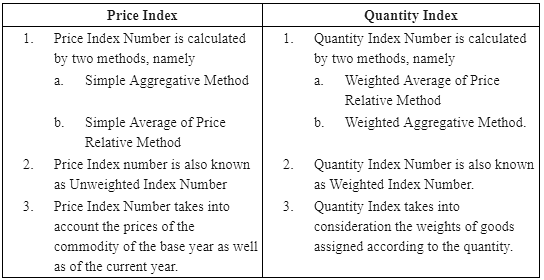
Q12: Is the change in any price reflected in a price index number?
Ans: No, the change in any price is not reflected in a price index number. In fact, only the relative change or the percentage change in the price level is reflected in the price index number. Index numbers of prices are not simply a statement of prices at different dates, but they present the estimates of relative changes in the prices over the years with reference to a particular base year.
Q13: Can the CPI number for urban non-manual employees represent the changes in the cost of living of the President of India?
Ans: The CPI for the urban non-manual employees cannot represent the changes in the cost of living of the President of India. This is because the consumption basket of the non-manual employees consists of different items than those of the consumption basket of President of India. In fact, in India CPI for industrial workers is the most popular index. This is used by the government to regulate Dearness Allowance (D.A.) to compensate its employees against the price rise. Hence, the CPI for the industrial workers cannot represent the changes in the cost of living of the President of India.
Q14: The monthly per capita expenditure incurred by workers for an industrial centre during 1980 and 2005 on the following items are given below. The weights of these items are 75, 10, 5, 6 and 4 respectively. Prepare a weighted index number for cost of living for 2005 with 1980 as the base.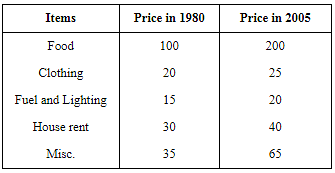 Ans:
Ans: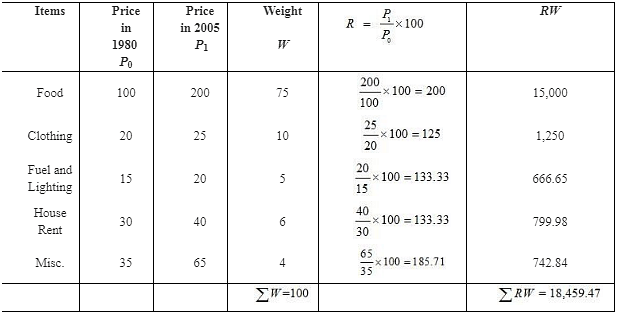

Q15: Read the following table carefully and give your comments.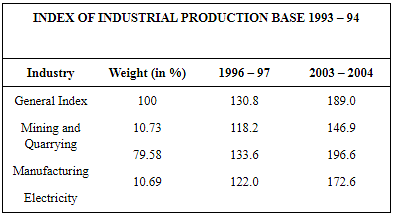 Ans: The following conclusions can be made by analysing the above table.
Ans: The following conclusions can be made by analysing the above table.
- Manufacturing Industry has the highest weight of 79.58% as compared to the Mining and Quarrying and Electricity Industries that accounts for 10.73% and 10.69% respectively.
- The production of Manufacturing Industry is higher than that of the Mining and Quarrying and Electricity Industries in both the years 1996-97 and 2003-04.
- Mining and Quarrying has the least growth performance while that of the Manufacturing Industry is the highest.
- The General Index is comparatively higher in the year 2003-04 than 1996-97.
Q16: Try to list the important items of consumption in your family.
Ans: The following items constitute the total consumption needs of our family
Q17: If the salary of a person in the base year is Rs 4,000 per annum and the current year salary is Rs 6,000, by how much should his salary rise to maintain the same standard of living if the CPI is 400?
Ans:
Base CPI = Rs 100
Current CPI = Rs 400
Base Year Salary = Rs 4,000
Current Year Salary = Rs 6,000
Thus, his salary should be Rs 16,000. Therefore, in the current year his salary should increase by Rs 10,000 (i.e. Rs 16,000 – Rs 6,000) so as to maintain the same level of living in the current year as that of the base year.
Q18: The consumer price index for June, 2005 was 125. The food index was 120 and that of other items 135. What is the percentage of the total weight given to food?
Ans: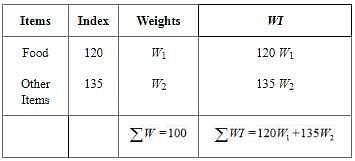 Let the total weight = 100
Let the total weight = 100
W1 denotes weight of food
W2 denotes weight of food other items
So, W1 + W2 = 100 (i)
CPI = 125
12500 = 120 W1 + 135 W2 (ii)
Subtracting equations (ii) from (i)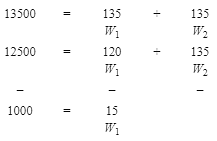

Substituting the value of W1 in the equation (i)
W1 + W2 = 100
Or, 66.67 + W2 = 100
W2 = 33.33
Percentage of total weights given to food is 66.67% and other items is 33.33%
Q19: An enquiry into the budgets of the middle class families in a certain city gave the following information;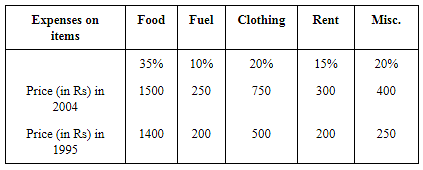 What is the cost of living index of 2004 as compared with 1995?
What is the cost of living index of 2004 as compared with 1995?
Ans: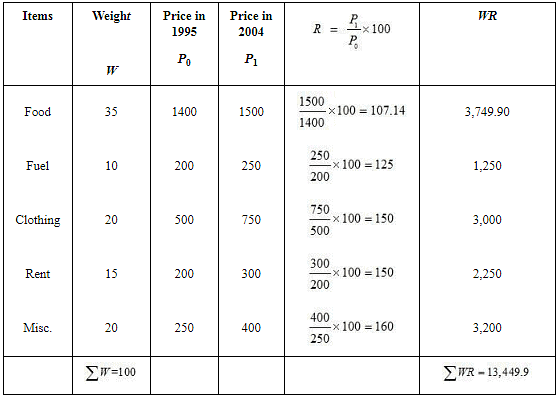

Cost of Living Index = 134.50
Thus, the prices rose by 34.50% during 1995 and 2004.
Q20: Record the daily expenditure, quantities bought and prices paid per unit of the daily purchases of your family for two weeks. How has the price change affected your family?
Ans: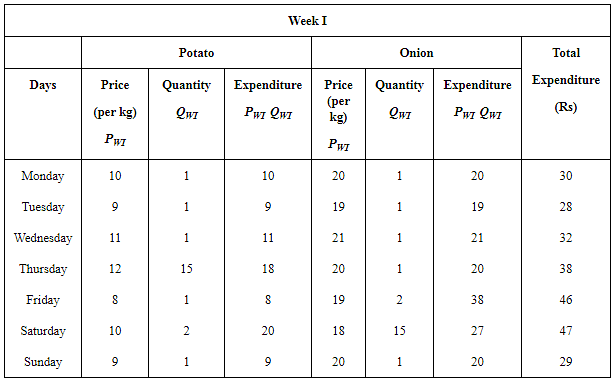
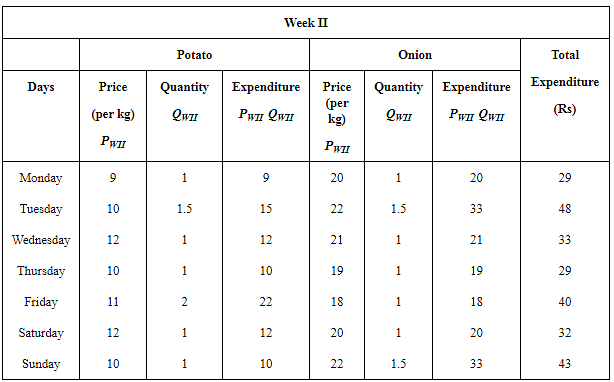 The household on Monday of week one (WI) spend Rs 30, by buying 1 kg of Potato and 1kg of Onion at Rs 10 and Rs 20 per kg respectively, whereas, the price of Potato on Monday of the week second (WII) has reduced from Rs 10 to Rs 9 resulting in the reduction in the expenditure incurred by the household. Therefore, we can conclude that the decrease in price leads to decrease in expenditure given the quantity purchased. We can also analyze that the price and quantity purchased by the household shares a negative relationship with each other.
The household on Monday of week one (WI) spend Rs 30, by buying 1 kg of Potato and 1kg of Onion at Rs 10 and Rs 20 per kg respectively, whereas, the price of Potato on Monday of the week second (WII) has reduced from Rs 10 to Rs 9 resulting in the reduction in the expenditure incurred by the household. Therefore, we can conclude that the decrease in price leads to decrease in expenditure given the quantity purchased. We can also analyze that the price and quantity purchased by the household shares a negative relationship with each other.
Q21: Given the following data: Source: Economic Survey, Government of India 2004-2005
Source: Economic Survey, Government of India 2004-2005
(i) Calculate the inflation rates using different index numbers.
(ii) Comment on the relative values of the index numbers.
(iii) Are they comparable?
Ans:
(i)
(a)
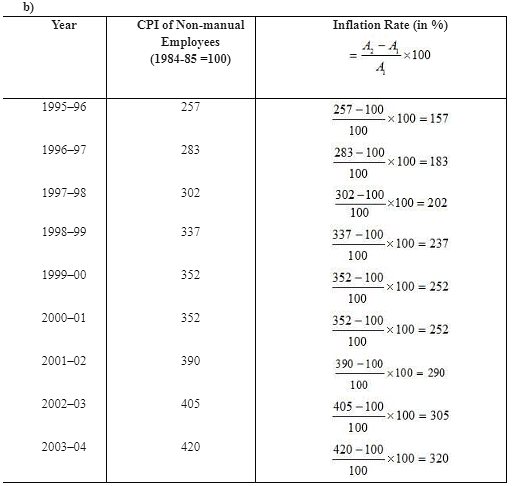
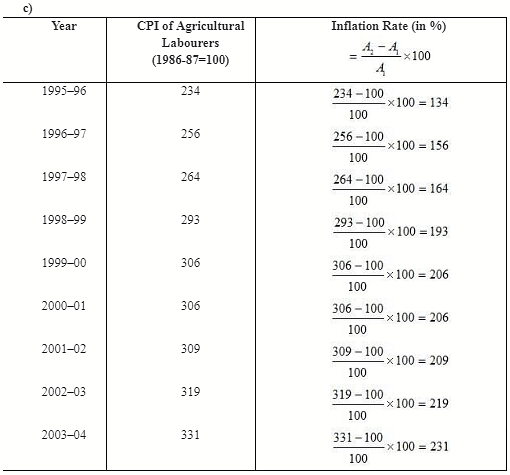
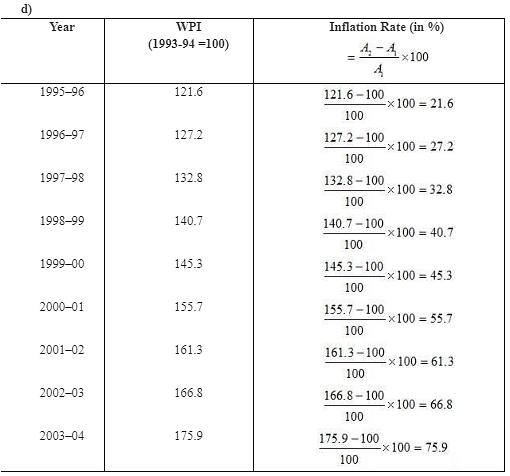 (ii) The inflation rate for industrial worker with the base year 1982 is the highest and WPI with the base year 1993-94 has the least.
(ii) The inflation rate for industrial worker with the base year 1982 is the highest and WPI with the base year 1993-94 has the least.
(iii) No, the index numbers are not comparable because of the following reasons:
- Base periods for CPI of industrial workers, urban non-manual workers, agricultural labourers and WPI are different.
- Commodities and their weightage given to different index may vary from one index number to another.
|
58 videos|215 docs|44 tests
|
FAQs on NCERT Solutions for Class 12 Economics - Index Numbers
| 1. What are index numbers? |  |
| 2. How are index numbers calculated? |  |
| 3. What is the importance of index numbers in economics? |  |
| 4. How are index numbers used in business? |  |
| 5. Can index numbers be negative? |  |

|
Explore Courses for Commerce exam
|

|


















